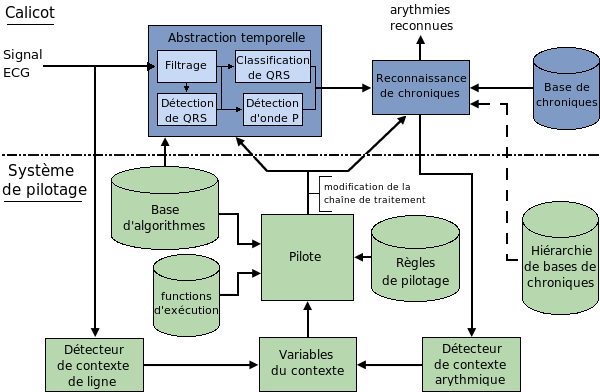
Project presentation
›› Medical context
Cardiovascular diseases represent one of the first cause of mortality in the world (for more information consult the website of the World Health Organization). Coronary Intensive Care Units were created in the sixties for supervising patients admitted in hospital after a cardiac accident. Their aim is to analyze online cardiac signals (ECG and pressure), to detect abnormal situations, to characterize cardiac arrhythmias online (look here for more information on cardiac arrhythmias) and to alert the clinical staff when some therapeutic action is required. Significant progress has been made leading to a decrease of mortality but the number of false alarms emitted by monitoring devices is still too high (cf. Thierry Soulas's PhD) and remains an obstacle to their dissemination.
›› Goals
The aim of the Calicot project is to develop an intelligent monitoring system meeting the objectives of coronary intensive care units as well as minimizing false alarms. The proposed approach associates
›› Architecture

|
|
General architecture |
1 - Temporal abstraction module (Online): inputs cardiac signals (ECG), analyzes them with signal processing methods tailored to QRS and P wave detection and returns, using classification techniques, a symbolic description of signals based on timestamped events.
2 - Diagnosis module by chronicle recognition (Online): analyzes the event flow and attempts to recognize patterns or chronicles denoting arrhythmia disorders. For more details about diagnosis by chronicle recognition consult
the bibliography of CRS.
We are using the CRS chronicle recognition system.
3 - Chronicle database (Used online): it contains the set of chronicles that are associated to the cardiac arrhythmias that should be detected.
3bis - Pilot (Online): it is in charge of adapting the diagnosis to the current context. Two means can be used to adapt the computation to the current situation:
4 - Chronicle learning module (Offline). It is in charge to induce discriminant patterns or chronicles related to cardiac arrhythmias from learning examples labeled by cardiac arrhythmias. It uses an inductive logic programming (ILP) technique. For more information on ILP consult this website.
Here is an article in French about online monitoring of cardiac arrhythmias bay chronicle recognition.